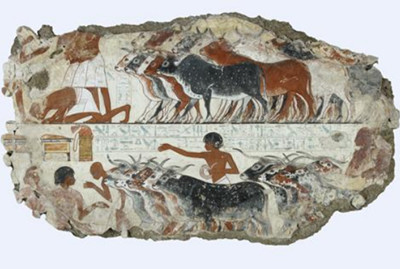The story begins over nine thousand years ago, in the vast expanses of the Sahara. In Egypt then, instead of today's landscape of arid desert, the Sahara was a lush, open savannah with gazelles, giraffes, zebras, elephant and wild cattle roaming through it - happy hunting for humans.
故事大概開始于九千年前左右,在撒哈拉那廣袤無垠的土地上。然而當年的埃及,可不是如今這般干旱荒涼的沙漠景觀,那年的撒哈拉一派郁郁蔥蔥、草水豐盛、一望無際的熱帶稀樹大草原,羚羊、長頸鹿、斑馬、大象和野牛等動物就在這片沃土上生息繁衍——對人類而言,這卻是一片狩獵的沃土了。
But around eight thousand years ago, the rains that nourished this landscape dried up. Without rain, the land began to turn to the desert that we know today, leaving people and animals to seek ever-dwindling sources of water. This dramatic change of environment meant that people had to find an alternative to hunting.
然后大概在八千元前左右,曾經滋養著這方水土的雨水突然干涸。沒有了雨水,土地開始沙化,逐漸演變成我們今天所熟悉的大沙漠,迫使人類與動物背井離鄉,到處尋找日益減少的水源。這種戲劇性的劇烈環境變化,意味著人們不得不尋找一種方式來代替狩獵。
Somehow they found a way to tame wild cattle. No longer did they just chase them, one by one, they learnt how to gather and manage herds, with which they travelled and from which they could live. Cows became almost literally the lifeblood of these new communities. The needs of fresh water and pasture for the cattle now determined the very rhythm of life as both human and animal activity became ever more intertwined.
也不知如何,他們尋找到了一種方法來馴服野牛。人類不再逐一地追逐著野牛,而是學會了如何集合它們,如何馴化它們。人類在遷徙的過程中帶上了牛群,人類依靠著牛群而生存。牛群于是漸漸變成了這種新興人類群體的生命線。隨著人類與牛群彼此互動變得越來越相互交織,尋找牛群所需的新鮮水源與肥沃牧草開始變成人類生活的主旋律。
What role did these early Egyptian cattle play in this sort of society? What did they keep cows for? Professor Fekri Hassan has excavated and studied many of these early Egyptian graves:
那么在早期古埃及社會,牛群扮演了什么樣的角色呢?人們養牛群在干什么?法克瑞·哈桑教授挖掘與研究過許多這些早期的古埃及墳墓:












